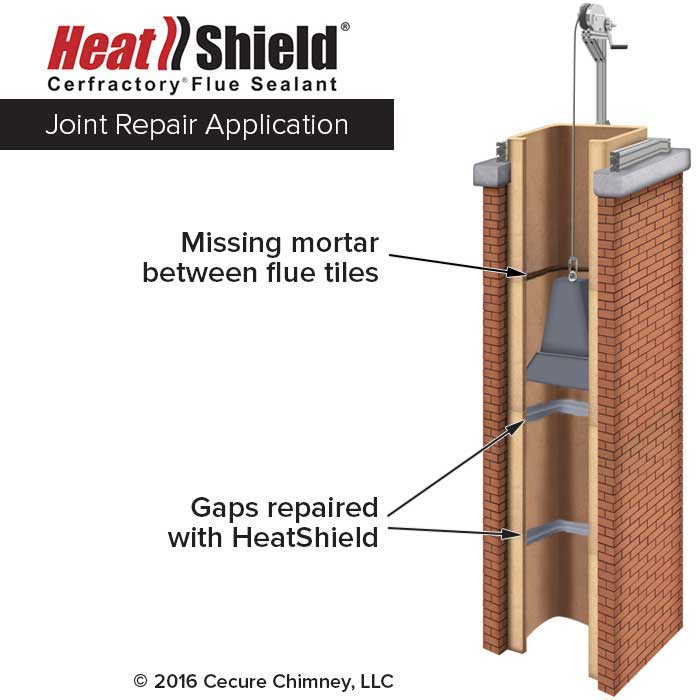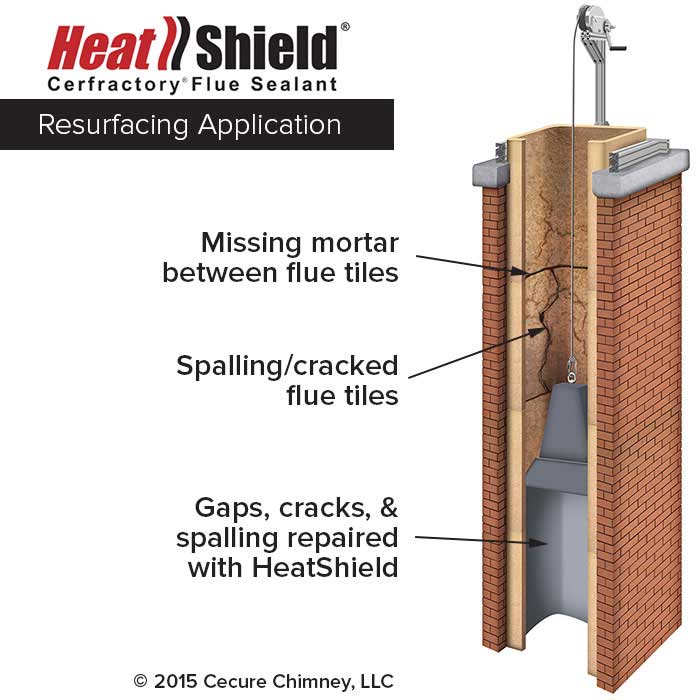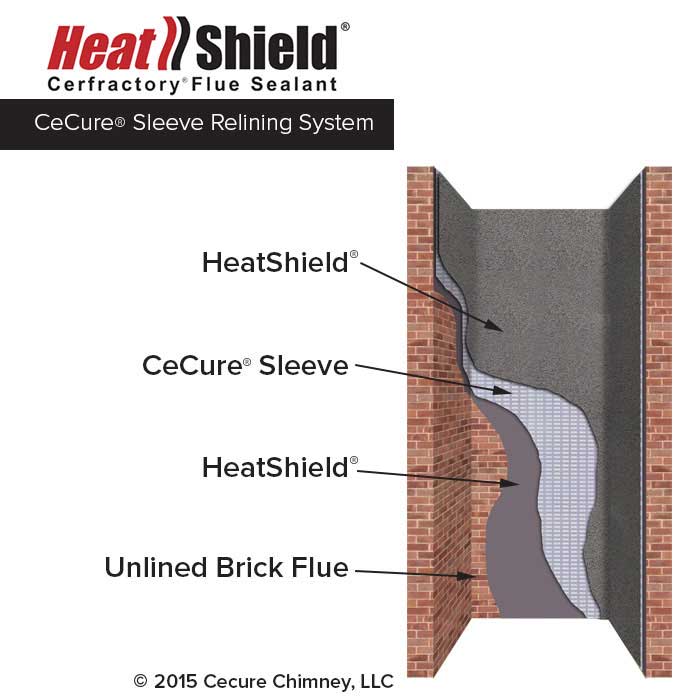Garden State Chimney Is the Place To Call for All Your Chimney Relining Needs
When you close your eyes and picture a chimney, what do you see? Chances are you’ve conjured a vision of an egress protruding from the roofline, either made of brick and mortar or paneled in wood… a metal cap sitting atop the highest point… maybe some swirls of smoke wafting away on the breeze.
We’d venture to guess that you did not, however, think about the smoke chamber, the damper, or any other of the vitally important internal components of such a structure, like a chimney liner. Luckily, if you’re a homeowner in Northern (and parts of Central) New Jersey, you don’t have to – you just have to pick up the phone and call Garden State Chimney.
A full-service, licensed, and insured chimney maintenance and repair company, the team of technicians at Garden State are your local experts for all matters concerning your fireplace and chimney. No matter if you’re looking to install a new appliance, need utility flue relining, or believe you are in need of a chimney relining service, trust us to take care of it all. We only hire professional chimney techs who are Chimney Safety Institute of America (CSIA)-certified and place a high value on serving our community with kindness and transparency.
To learn more about us and how we can help you, fill out a contact request form right here on our website, or you can give us a call at 321-CHIMNEY.
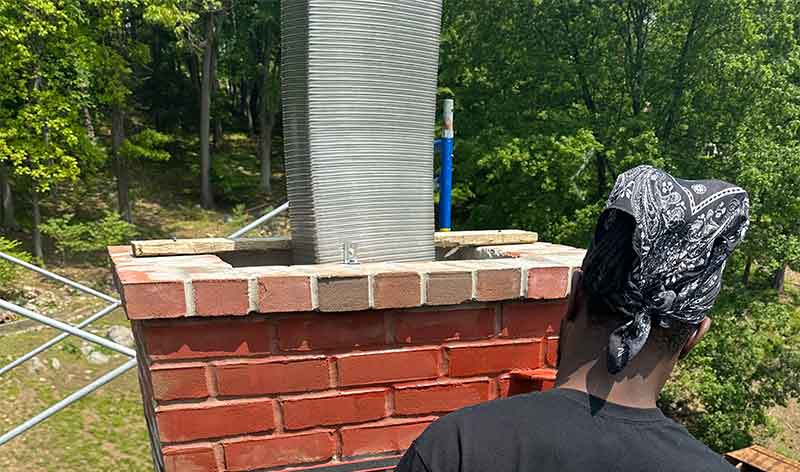
What Is a Chimney Liner?
Find yourself scratching your head and wondering, “Chimney relining? What is a chimney liner in the first place?” Don’t worry – you’re not alone. It’s not uncommon to be unfamiliar with the inner workings of your chimney.
Essentially, a chimney liner is constructed out of several different materials (primarily terra cotta clay and a variety of metals – we’ll go more in-depth later) and is designed to protect the inner walls of your chimney against ghastly high temperatures and dangerous gases. In addition, it should also streamline and control the airflow through your chimney.
When there are structural inefficiencies like cracks, gaps, holes, or any other kind of separation, it’s not just the chimney’s liner that suffers, but the system as a whole. Actually, several decades ago – first, the 1940s and then 40 years later in the 1980s – tests were performed by what was then known as the National Bureau of Standards (NBS) and is now called the National Institute of Standards and Technology (NIST) on the safety of chimney systems. Through this research, the scientists studying the results came to the conclusion that building a chimney without a liner was “little less than criminal” because of how fast surrounding woodwork and other materials could catch fire. If you were wondering, it’s around three and a half hours. Not great.
Why Would a Chimney Need To Be Relined?
Having defined what a chimney liner is and why it’s absolutely vital for your system to sport one, the next question might be, “What would cause the need for relining?”
Another top-notch query. For starters, as with all other home appliances, your chimney liner can deteriorate over time – especially if the system is not being used properly or annual maintenance services are neglected. However, even if you do operate your fireplace according to manufacturer instructions and always make sure to schedule your annual inspection and chimney cleaning, natural wear and tear can take its toll too.
Because the concept of chimney liners is relatively new (within the last several decades, anyway), it is possible for an existing chimney to not have a liner. Particularly if you live in a home built pre-’40s. This is not a “get out of jail free” card, however. Operating an unlined system can put you at risk for a handful of dangerous circumstances like:
- Exposure to harmful gases like carbon monoxide
- Disproportionate accumulation of soot, creosote, and other buildup
- Chimney fires that reach surrounding areas of the home
- General inefficiencies with the heating appliance’s performance
- Strange odors wafting into your living space
- Other problems where there does not seem to be an identifiable cause
Considering all the ways in which your chimney’s liner is necessary for optimal system performance, relining is just one of those services that is eventually inevitable. The method and overall process, however, will largely depend on your existing liner material and the sustained damage. Keep reading to learn more about chimney relining options.
Are There Different Methods To Relining a Chimney?
Every home – like the family that lives inside – is different. Why would a fireplace/chimney system be any different?
Because every chimney is a bit different both in stature and construction material, relining services must reflect this. What might be a very viable, smart option for a traditional brick masonry chimney may likely not even be a possibility for a prefabricated system.
That’s where we come in. Professional chimney service companies like ours will come take a look at what you’ve got going on and lay out the relining options that would best suit your budget and your chimney.
When it comes to your relining options and depending on the state and material of the existing chimney liner, the choice is between two: HeatShield® and stainless steel.
What Is HeatShield® Resurfacing for Chimneys?
First developed in Europe, HeatShield® is a chimney liner repair solution that coats the inside of your chimney’s liner with a uniquely formulated sealant made of both ceramic and refractory materials. Referred to as “Cerfractory,” this sealant is available in three separate application processes – depending on the state of damage sustained by the chimney liner – and provides an alternative to complete liner replacement for chimneys lined with terra cotta clay tiles.
As a full service chimney repair and maintenance company, our aim is to provide local homeowners in the Passaic County area with ample relining options. No matter if your chimney is prefabricated or traditional masonry, Garden State Chimney has a relining solution designed to fit your needs. That’s why we are proud to offer and install the various HeatShield® repair systems designed to reinforce your current clay liner in addition to our total replacement relining options.
What HeatShield® repair options are available?
So, HeatShield® is available in three different application methods: Joint Repair, Resurfacing, and CeCure Sleeve Relining. What does this mean, exactly? Basically, depending on the severity of damage to your liner, our approach to utilizing and applying the HeatShield® sealant will look a little different. Here’s a brief overview of each repair system:
Joint Repair
The most basic relining system offered through HeatShield®, the joint repair service is designed to seal damaged mortar joints between the clay liner tiles. Utilizing a unique tool specified to the dimensions of your chimney, we are able to fill in all missing or deteriorating mortar. However, this specific repair procedure cannot be applied when there are any cracks, fractures, or separations found in the individual tiles themselves.
Resurfacing
Created for liners that may have endured a bit more damage, the next method is a bit more intense as it involves applying the HeatShield® sealant product throughout the entire flue liner. In this resurfacing service, we first have to prime the chimney flue with a material designed to remove leftover dust and debris before we can go in with the actual HeatShield® Cerfractory® material. At the end, we utilize a camera to ensure the application went smoothly and your chimney is once again suitable for regular use.
CeCure Sleeve Relining
Sometimes, your flue liner can really take a beating. Whether due to a disaster like a chimney fire or some other similar event, the chimney liner is usually the part of the system that takes the brunt. As long as the liner is still somewhat intact (or in the case of a previously unlined chimney, the brickwork still looks solid), we can apply HeatShield®’s most intense repair: the sleeve relining.
The preparation stage looks the same as the first two application methods, but this process requires a sort of customized thin panel reinforced with stainless steel and insulated in ceramic to be lowered into the chimney sandwiched between the original HeatShield® sealant product. Once everything has been properly applied, we go in with a camera to ensure it is as it should be.
How Do I Know if HeatShield® Would Work for My Chimney?
Well, that’s kinda the tricky part. Even if you fancy yourself a Dick Van Dyke superfan and spend a considerable amount of time peering down your chimney from the roof (which, for your safety and sanity, we hope is not the case), it’s very unlikely that you would know what you’re looking for. However, if your chimney sports a terra cotta clay liner, there is always a chance that one of the three HeatShield® application methods will work for you.
Want to know more about HeatShield® and how it works? Or maybe you’re interested in tearing out your clay liner to replace it with something a bit more modern? Looking for answers to something else? We’d love to hear from you and see which of our chimney repair or other maintenance services would best suit your needs. You can contact us right here online or by calling 321-CHIMNEY.
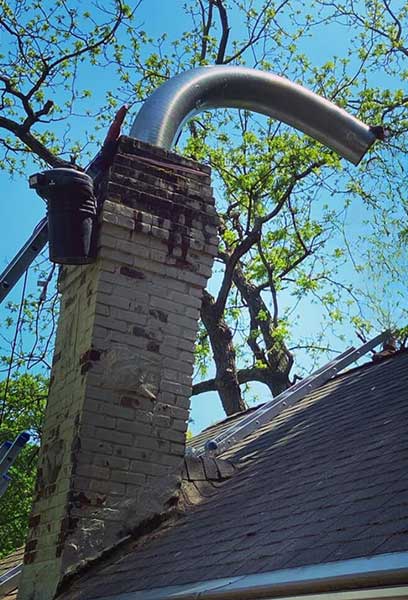
Is Stainless Steel a Good Chimney Relining Option?
Yes, absolutely. Actually, as far as replacement liner options go, stainless steel is one of the best.
Chimney parts and pieces are commonly constructed of two different kinds of metals: aluminum and stainless steel. Both are created in the shape of a long flexible tube that runs the entire length of the chimney flue. While aluminum often has a much lower price point, its properties reflect that. Weaker than steel, aluminum is not built to last and though it may be an attractive option (especially for gas-fueled appliances) for liner replacements, it will also likely require more maintenance – or even another replacement shortly down the line.
Stainless steel, on the other hand, is made to last, and, depending on the specific grade or alloy, is quite versatile. Why does the alloy matter? Because combustion fueled by different sources creates different gases, fumes, and other harsh byproducts, the grade of metal constructing the liner matters a great deal.
For example, a stainless steel liner in a wood-fueled fireplace system may be designed to withstand the temperatures and exhaust associated with wood, but if the same one was installed in a gas-fueled appliance? The higher levels of acidity found in the gas smoke could burn through it. That’s why it is important to work with a professional when finalizing your options for a chimney relining service.
What Are the Different Types of Chimney Liners?
Technically speaking, there are officially three different kinds of chimney liners:
- Terra cotta/clay
- Metal (either stainless steel or aluminum)
- Cast-in-place
However, terra cotta and stainless steel are the two most common options. Installing a cast-in-place liner is rare these days because the process is quite labor intensive and the price of such a service reflects that. While terra cotta is a popular liner material for brick chimneys, most prefab systems will utilize a certain alloy of steel in accordance with whichever fuel is burned. Because of the ease of installation and overall versatility between these two materials and the range of models they work with, cast-in-place liners continue to slowly die out.
How Long Do Chimney Liners Last?
Well, it depends. There are quite a few factors that help determine the overall lifespan of a chimney liner. Things like: the liner material, frequency of system use, general well-being of the chimney, and more can affect just how long your liner will last.
Take terra cotta liners, for example. Constructed of a material designed to withstand extremely hot temperatures and direct contact with smoke, any rapid change in temperature or the presence of actual flames (as in what occurs during a chimney fire) can cause these tiles to expand too quickly and crack. Even if your masonry was just built, your liner spankin’ new, if the temperature in the flue increases too quickly and fractures the tile, it will need immediate repair before you can enjoy any more time in front of your fireplace.
That being said, provided you care for your system properly and always make note of strange behaviors, smells, inefficiencies, or any other oddities – and have them investigated by a professional chimney sweep – a clay liner may last anywhere from 15 years to 50.
The stats are similar for stainless steel liners. Not only does it depend on your maintenance schedule and attention, but also other factors that may be out of your control. Among others – like the health and soundness of the system itself – this is one of the biggest reasons why it is so important to have your chimney inspected and swept at least once a year. It is during these services that we are able to determine what next steps to take, if any, to ensure everything works as it should.
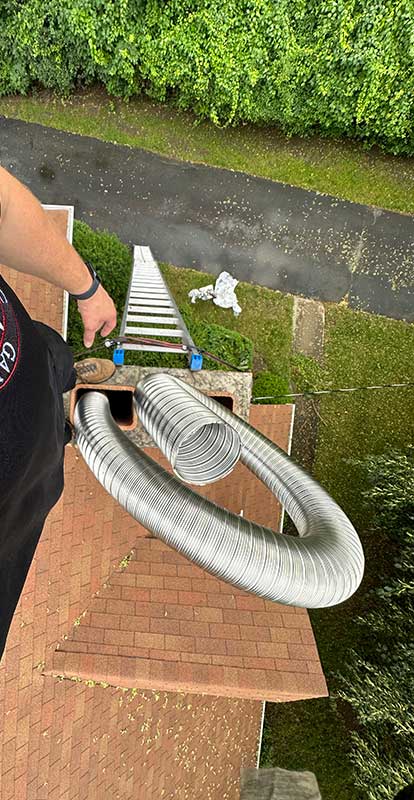
What Are the Signs of a Damaged Chimney Liner?
Much in the way that it is quite difficult to discern whether or not your liner may be a candidate for a HeatShield® relining option, it can be challenging to know when your chimney’s liner has reached the end of its life. However, even without an official inspection, there are a few things to keep an eye out for:
- Higher volume of creosote or other debris accumulation
- Odors coming from your fireplace
- Bits of clay or brick in or around your fireplace
- Inefficiency in heat production or system performance
If any of these signs or symptoms sound familiar, it’s because, without the proper equipment and industry expertise, many chimney issues that require a repair manifest similarly.
Is your fireplace acting up? Worried about the state of your chimney liner? Call on the team at Garden State to check it out. Servicing homes in Northern and parts of Central New Jersey, we’re the ones who get it done. Book a service with us through our website or give us a call at 321-CHIMNEY.
Can I Use My Chimney if the Liner Is Damaged?
We figure this should go without saying, but if, at any point, you notice that your fireplace/chimney is acting up, do not use it. Even if it doesn’t seem like a big deal, even if you’ve been waiting all day to plop down and curl up in front of your hearth, don’t.
We know – it’s painful for us, too. But wanna know what’s more painful? Using a fireplace that is not up to code and industry regulations. The results of which can vary from exposing yourself, your family, and your entire home to dangerous gases to starting a chimney fire that could have drastic (and expensive) consequences.
When in doubt, wait it out until you schedule a time for one of our professionals to come and assess the situation. When it comes to operating the system that literally contains a burning fire inside of your home, we always believe being cautiously proactive is far better than any alternative.
Can I DIY Chimney Relining?
Our answer is a solid no. Considering the level of skill required to not only break apart and remove a liner in pieces (as is the case with terracotta too damaged to qualify for a HeatShield® repair), but to correctly and efficiently install a replacement, a DIY approach to chimney relining is simply not wise. While we certainly love the enthusiasm and “can-do” attitude, that energy might be better spent elsewhere than matters pertaining to your chimney or fireplace.
If you’re considering relining your chimney by yourself as a way to save money, we caution against it. Think about how much more you’d end up spending when you have to call a professional to do the service properly – as well as address any further repairs that resulted from a job done incorrectly. At Garden State, we not only provide timely and superior chimney repair and maintenance services, but our prices are affordable. Reach out to learn more.
Schedule Your Chimney Relining, Today
For homeowners near Passaic County, there is no place better than Garden State Chimney when it comes to properly maintaining your home heating system. Learn why we’re the superior chimney service provider in the Northern New Jersey area for cleaning, inspecting, relining, and more.
Give us a call at 321-CHIMNEY to get on our books, or if it’s better for you, reach out online. We look forward to meeting you and seeing what we can do for your home.
Call on us for gas fireplace service, and when you’re ready, we can also provides chimney cleaning and inspection services.

